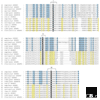Adenosine deaminases acting on RNA (ADARs): RNA-editing enzymes
- PMID: 14759252
- PMCID: PMC395743
- DOI: 10.1186/gb-2004-5-2-209
Adenosine deaminases acting on RNA (ADARs): RNA-editing enzymes
Abstract
Adenosine deaminases acting on RNA (ADARs) were discovered as a result of their ability extensively to deaminate adenosines in any long double-stranded RNA, converting them to inosines. Subsequently, ADARs were found to deaminate adenosines site-specifically within the coding sequences of transcripts encoding ion-channel subunits, increasing the diversity of these proteins in the central nervous system. ADARI is now known to be involved in defending the genome against viruses, and it may affect RNA interference. ADARs are found in animals but are not known in other organisms. It appears that ADARs evolved from a member of another family, adenosine deaminases acting on tRNAs (ADATs), by steps including fusion of two or more double-stranded-RNA binding domains to a common type of zinc-containing adenosine-deaminase domain.
Figures



References
-
- Hough RF, Bass BL. Purification of the Xenopus laevis dsRNA adenosine deaminase. J Biol Chem. 1994;269:9933–9939. This article and [4,5] describe the purification of ADAR1. - PubMed
-
- Kim U, Garner TL, Sanford T, Speicher D, Murray JM, Nishikura K. Purification and characterization of double-stranded RNA adenosine deaminase from bovine nuclear extracts. J Biol Chem. 1994;269:13480–13489. See [3]. - PubMed
Publication types
MeSH terms
Substances
LinkOut - more resources
Full Text Sources
Other Literature Sources
Molecular Biology Databases
Research Materials

